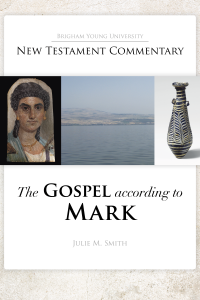Thanks to Dan Peterson, who wrote a feature in the Deseret News about our newest book, The Gospel according to Mark, by Julie M. Smith. He writes:
Each commentary volume includes a substantial introduction, followed by the King James Version translation, a fresh “New Rendition” from the original Greek in a parallel column, and detailed notes drawing on both mainstream modern biblical scholarship and uniquely Latter-day Saint sources.
Smith’s newly published commentary on Mark’s gospel weighs in at nearly 1,000 pages, with extensive explanations covering the entire text. Although it cannot be dismissed as a work of merely feminist scholarship, one of its welcome contributions is to provide a woman’s perspective on Mark and, thereby, on Jesus.
A case in point comes in a section titled “Jesus Heals a Woman and Raises a Girl” (pages 336-370) where Smith gives insightful and sensitive attention to the famous account in Mark 5:25-34 of the woman with “an issue of blood,” a story that, as she points out, “requires male audience members to relate to and sympathize with uniquely female concerns” and “suggests that Jesus shared these concerns.” Moreover, she says, “The intertwined stories of the bleeding woman and Jairus’s daughter may be Mark’s most intricately plotted and symbolically rich text.”
According to Jewish law, the bleeding woman’s touch should have made Jesus ritually unclean. However, it doesn’t. Or, if it does, he appears not to care. This, says Smith, “is a commentary about Jesus’ relationship to the law of Moses.” Moreover, discussing Jesus’ question about who had touched his clothes, Smith remarks that “A Jewish audience may have thought that Jesus wanted to know who had touched him so that she could be rebuked for transmitting impurity.” But “the story plays out very differently.”
“Mark,” Smith observes, “had introduced the woman by calling her a woman with ‘an issue of blood.’” She had no name, no relationships, no geographical location; her disease is the sole marker of her identity. But in this verse (5:34), Jesus gives her a new identity marker: she is his daughter.
I cannot begin to summarize or even outline the richness of Smith’s discussion of this episode, which includes fascinating parallels and contrasts with Zechariah 8:23, 1 Samuel 1, Jeremiah 8 and, intriguingly, Genesis 3.
And space permits me only to hint at the intriguing suggestions that Smith offers about the women witnesses of Christ’s Resurrection and the possible role of women in the transmission of Mark’s gospel itself. Read the book! Or its e-book!
For an earlier example of Smith’s approach to the story of the bleeding woman that is accessible at no charge online, see her article “A Redemptive Reading of Mark 5:25-34,” in “Interpreter: A Journal of Latter-day Saint Faith and Scholarship” 14 (2015): 95-105; online at mormoninterpreter.com/a-redemptive-reading-of-mark-525-34/.


